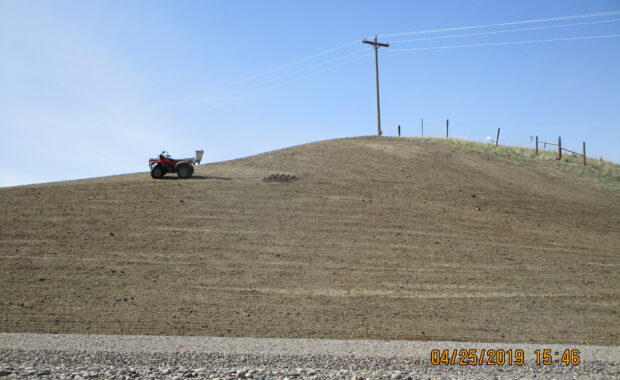Montana’s climate presents challenges for the revegetation of disturbed lands. In southwest Montana, growing seasons are generally between 50 and 100 days. The valleys are about 5000 feet in elevation and annual precipitation, mostly in the form of snow, ranges from 5 to 15 inches. Elevations above tree line (>8000 feet) receive more precipitation with 100 to 500 inches of annual snowfall. Our company manages vegetation for reclamation and restoration projects, which requires spring (March-April) and fall (October-November) seeding on highly disturbed and non-irrigated landscapes.
We design seed mixes and perform custom seeding for a wide variety of purposes. Cover crops can be a cheap and practical tool used to provide short-term stabilization of soil and other earthen materials. Our use of cover crop technology is applied in mine operations for the proper management of large topsoil stockpiles, and for temporary erosion control on recently disturbed areas prior to final reclamation. We also use cover crops for rapid revegetation of floodplain soils and streambanks on restoration projects, where native grasses, forbs, and shrubs may take years to fully establish.
Given the cold and semi-arid climate, we prefer specific varieties of cover crop species. When grass cover crops are desired, we use annual ryegrass, beardless barley, winter and red spring wheat, and sterile wheat hybrids. For longer periods of cover, we use Pubescent and Intermediate wheatgrass, and varieties of Siberian and Crested Wheatgrass. Grasses provide abundant organic residue but can deplete soil of limited nitrogen reserves. Annual and perennial grasses are very resistant to infestation by weeds. They can also be very persistent, which is problematic for some land use objectives.
Legumes can fix significant amounts of atmospheric nitrogen (> 100 lbs./ac.). Cold and drought tolerant legumes include many varieties of alfalfa and clover, and American and Hairy vetch. Legumes produce abundant organic residue and they decompose rapidly. Most legumes require inoculation with species-specific rhizobial bacteria. Some species of clover will establish on loose aggregate, and are so aggressive as to be considered invasive weeds. In our area, wildlife and livestock have a strong affinity to introduced palatable legumes, and they are quickly eliminated by selective grazing.
A final consideration for those working with salvaged topsoil that has been buried at great depth (> 6 feet) for long time periods (> 1 year). We often work with “soils” that lack organic matter (<1%) and are biologically inert. We have recently considered using the Haney Soil Test (R. Haney, USDA-ARS, 2014) and the PLFA Test (Phospholipid Fatty Acid) for characterizing the biological activity (or lack of) in old and deeply buried topsoil reserves. The Haney Test to determine “soil health” is a broad assessment of microbial activity and the available, soluble, organic nutrients. The PLFA Test gives a representation of existing living soil microbial biomass including different bacterial groups, actinomycetes, arbuscular mycorrhizal fungi, rhizobia, protozoa, and microorganisms. These soil tests may reveal biological deficiencies that can be enhanced with available soil amendment products.

Prepared by John Whittingham, Hydrologist, M.Sc., PWS, CPESC, Montana Representative, IECA
Owner, Basic Biological Services LLC, info@basicbiologicalservices.com
Montana Events Calendar
Montana Soil Health Symposium, Billings, MT, February 4,5
hosted by SWCDM and MT NRCS, mtsoilhealth.org
Montana Water Summit, Helena, MT, March 3, 4
hosted by Montana Watershed Coordination Council, smeloy@mt.gov
